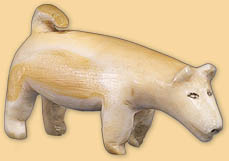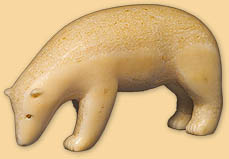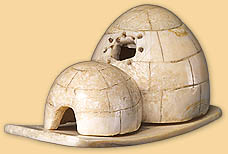 |
As early as 1894, Reverend Peck established an Anglican mission on
Blacklead Island in the Cumberland Sound area of Baffin Island. A
formidable linguist, Reverend Peck translated the Bible into Inuktitut,
wrote a book on Eskimo Grammar and an Eskimo-English Dictionary. Peck
successfully spread the use of the syllabic writing system that was
adapted for Inuktitut from Cree by John Horden and E. A. Watkins,
English Missionaries in Moosonee.*
Reverend Peck was on Blacklead Island from 1894 until 1902, with
some interruptions due to illness and family problems.**
In 1973, a Mrs. Helga Peck donated a collection of ivories,
accompanied by the note: "Collected by Reverend E. J. Peck while
a missionary in the North of Canada." We can assume that he
collected them while on Baffin Island because some detail in the
clothing of one figure is found only in that area.***
* Harper, Kenn
1983 – "Writing in Inuktitut: An Historical Perspective."
Inuktitut 53 (September): 13.
** Lewis, Reverend Arthur
1908 – Life and Work of E. J. Peck Among the Eskimos.
London: Hodder and Stoughton Press.
*** von Finckenstein, Maria
2003 – "Uqaamak's Collection: Historic Ivories at the Canadian
Museum of Civilization, part III." Inuit Art Quarterly 18 (3): 36.

 |
Figure of a Dog, between 1894–1902
possibly Blacklead Island, Cumberland Sound, Nunavut
Ivory, black colouring
2.5 x 4.7 x 1.2 cm
CMC IV-X-729
Collected by Reverend Peck while a missionary in the North of Canada
|
 |
Reverend Peck's entire collection appears to have been created by
the same artist, based on the style, and the texture of the ivory.
In this piece, details such as the stiff tail, the head pushed forward
eagerly, and the erect ears, all show the maker's acute powers of
observation and exceptional artistry.
Reference:
von Finckenstein, Maria
2003 – "Uqaamak's Collection: Historic Ivories at the Canadian
Museum of Civilization, part III." Inuit Art Quarterly
18 (3): ill. p. 36.
Bear, between 1894–1902
possibly Blacklead Island, Cumberland Sound, Nunavut
Ivory, black colouring
4.4 x 7.5 x 2.1 cm
CMC IV-X-720
Collected by Reverend Peck while a missionary in the North of Canada
|
 |
 |
This bear is not a miniature but a little sculpture; beautifully
tactile, demanding to be touched. We can easily imagine it as a
forerunner of the many bears created by contemporary Inuit artists.
Reference:
von Finckenstein, Maria
2003 – "Uqaamak's Collection: Historic Ivories at the Canadian
Museum of Civilization, part III." Inuit Art Quarterly 18 (3):
ill. p. 37.
Bowhead Whale, between 1894–1902
possibly Blacklead Island, Cumberland Sound, Nunavut
Ivory, black colouring
3.3 x 13.5 x 4 cm
CMC IV-X-715
Collected by Reverend Peck while a missionary in the North of Canada
|
 |
The bowhead whale played a huge role in the history of the
Cumberland Sound. Blacklead Island – where Peck's mission was located –
was in fact a whaling station. A small sculpture cannot possibly convey
the gigantic size of the whale. However, the artist, who also created
the bear, has captured the essence of the animal, with its bulky body
and distinctly shaped mouth.
 |
Snow House with Porch,
between 1894–1902
possibly Blacklead Island, Cumberland Sound, Nunavut
Ivory, black colouring
5.5 x 12.5 x 5.4 cm
CMC IV-X-716
Collected by Reverend Peck while a missionary in the North of Canada
|
 |
Reverend Peck describes his surroundings in his diary: "Item
one is the Eskimo village. This consists of fourteen snow-houses.
These are built amongst huge boulders of ice and look like large
bee-hive shaped piles of snow."*
*Lewis, Reverend Arthur
1908 – Life and Work of E. J. Peck Among the Eskimos.
London: Hodder and Stoughton Press, p. 250.
|